
Solving Power and Exponential Equations Video 2
Solving equations with exponential terms

Solving equations with exponential terms

Solving equations with base e exponential terms

Properties of exponential growth and decay functions

Properties of the exponential function with base e

Explaining the basic properties of logarithmic functions

Explaining how to solve logarithmic equations

Solving logarithmic equations with a single logarithm term

Solving logarithmic equations with multiple logarithm terms

Solving logarithmic equations with multiple logarithm terms on both sides

Solving an equation an exponential function

Solving an equation with exponential functions

Solving an equation with a logarithmic function

Solving an equation with several logarithmic functions

Finding the domain of a function with a root and a logarithm in the denominator

Solving equations with even roots and checking the solutions

Solving equations with odd radicals

Solving an equation with logarithmic functions

Solving an equation with logarithmic functions

Solving an equation with logarithmic functions

Solving an equation with logarithmic functions

Solving an equation with logarithmic functions

Finding the domain, range, end behavior, and intercepts for a logarithmic function

Using logarithms to transform an exponential function to a linear function

Using logarithms to transform a power function into a linear function

Determining the graph of a logarithmic function

Determining the graph of a logarithmic function

Solving an equation with an exponential function

Solving an equation with exponential functions by factoring

Explaining the graph and properties for the parent function of quadratics

Solving equations with multiple radicals

Explaining the general properties of even and odd root functions
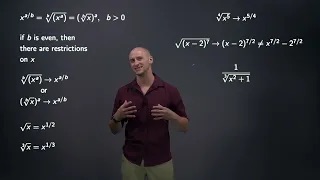
How to rewrite radical terms as power terms

Explaining how to solve radical equations and then solving example problems

Simplifying an expression with both power and exponential functions using properties of exponents

Simplifying power and exponential expressions using properties of exponents
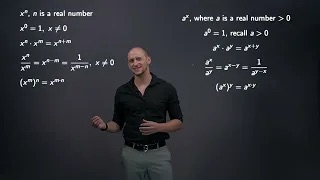
Properties of exponents applied to power and exponential expressions

Properties of multiplying and simplifying power and exponential expressions

Properties of exponents applied to power and exponential expressions

Explaining the terminology and rules of logarithms

Expanding logarithmic expressions using logarithm rules

Condensing a logarithmic expression into a single logarithm

Discussing parent functions of rational functions and their properties

Finding the properties of an exponential function including domain, range, end behavior, and intercepts

Finding the properties of an exponential function including domain, range, end behavior, and intercepts

Finding the properties of an exponential function including domain, range, end behavior, and intercepts

Solving an equation with exponential functions

Solving an equation with exponential functions

Evaluating a logarithm inside an exponential function

Finding the domain of a function containing a logarithm, exponential, radical, and fraction

Finding the domain of a function containing a logarithm, exponential, and fraction
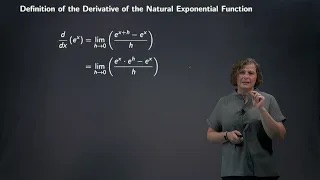
Explaining the formulas for the derivatives of exponential functions

Explaining the definition of logarithmic scale and double-log plots
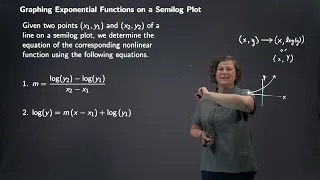
Explaining the logarithmic scale and a semilog plot

Writing a non-linear function to represent the line graphed on a semilog plot

Using the second derivative to find the maximum rate of change in a word problem

Determining properties of an exponential function

Determining properties of an exponential function

Determining properties of an exponential function
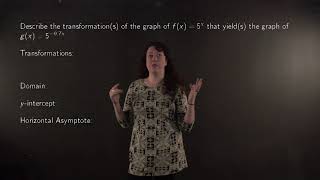
Determining properties of an exponential function

Identifying the graph of an exponential function

Determining the properties of a logarithmic function

Determining the properties of a logarithmic function

Solving an equation with an exponential function

Solving an equation with an exponential function

Modeling a population size with an exponential function

Review of limits and derivatives of inverse trigonometric functions

Review of limits and derivatives of inverse trigonometric functions

Mean Value Theorem and using derivatives to find the shape of curves

Properties and derivatives of inverse trigonometric functions

Continuity of Functions and the Intermediate Value Theorem

Properties and derivatives of inverse trigonometric functions

Using derivatives to find properties of graphs
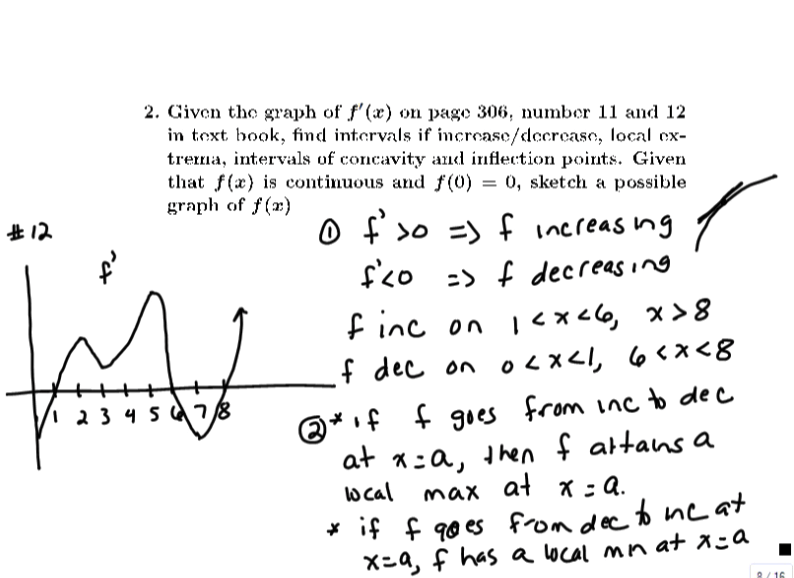
Using derivatives to find properties of graphs

Using logarithmic differentiation to find the derivative of a function

Using logarithmic differentiation to find the derivative of a function

Using logarithmic differentiation to find the derivative of a function

Evaluating a limit with an indeterminate power using L'Hospital's Rule

Evaluating a limit with an indeterminant power using L'Hospital's Rule

Review of limits and derivatives of inverse trigonometric functions

Review of limits and derivatives of inverse trigonometric functions

Mean Value Theorem and using derivatives to find the shape of curves

Properties and derivatives of inverse trigonometric functions

Continuity of Functions and the Intermediate Value Theorem

Properties and derivatives of inverse trigonometric functions

Proving facts about logarithms and exponentials including the derivative of an exponential with an arbitrary base

Using derivatives to find properties of graphs

Using derivatives to find properties of graphs

Finding and sketching the domain of a function of two variables

Explaining domain restrictions for denominators, even roots, and logarithms
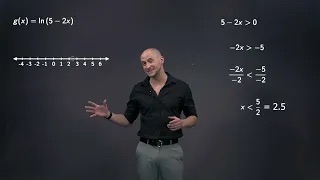
Finding the domain of a logarithmic function
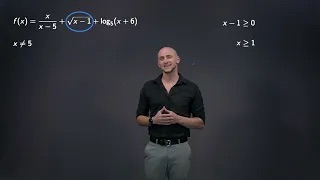
Finding the domain of a function with a denominator, square root, and logarithm

Finding the domain of a function with a natural logarithm and denominator

Discussing properties of linear functions

Discussing the types of linear graphs including horizontal and vertical lines and their properties
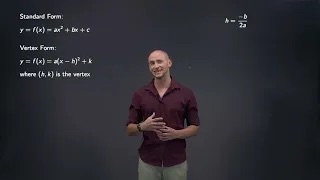
Discussing properties of quadratic functions including the vertex, domain, range, and end behavior

Explaining when a quadratic equation does not have a real solution

Simplifying power and exponential expressions using properties of exponents

Simplifying power and exponential expressions using properties of exponents

Solving equations that contain rational expressions

Solving an equation that contains rational expressions

Solving an equation that contains rational expressions

Sketching the level curves for a function of two variables

Writing logarithmic equations in exponential form

Solving equations with exponentials and logarithms

Solving equations with exponentials and logarithms

Solving equations with exponentials and logarithms

Determining if a graph represents a function and finding the domain and range

Solving a equation with an exponential function

Solving an equation with two exponential functions with different bases

Solving an equation with exponential functions by factoring

Solving a equation with exponential functions by factoring

Finding the domain and x-intercepts of a logarithmic function

Finding the domain and x-intercepts of a logarithmic function

Solving a logarithmic equation using properties of logarithms

Solving a logarithmic equation using properties of logarithms

Determining the domain and range of a relation and if the relation is a function

Determining the domain and range of a relation and if the relation is a function

Determining the domain and range of a relation and if the relation is a function
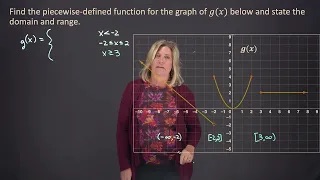
Finding the piecewise-defined function for a given graph along with its domain and range

Finding the domain of a function that is a fraction containing an exponential and root

Finding the domain of a function that is a fraction containing an exponential and root

Finding the domain of a function that is a fraction containing exponentials and a square root

Identifying the parent function and transformations for a given graph

Using properties of logarithms to determine whether a statement is true or false

Using properties of logarithms to determine whether a statement is true or false

Expressing a combination of logarithms as a single logarithm

Finding the domain of a function containing several logarithms

Finding the derivative a function with a power, exponential, and logarithm

Finding the derivative of a function that requires logarithmic differentiation

Using the Generalized Exponential Rule to find the derivative of a function

Using logarithm properties to simplify before using the Chain Rule to find a derivative

Using logarithm properties to simplify before using the Generalized Logarithm Rule to find a derivative

Using the alternate form of the Chain Rule to find the derivative

Solving an indefinite integral by first simplifying the fraction

Calculating a derivative of a quotient with an exponential function

Writing a non-linear function for the graph containing two points on a double-log plot

Determining the properties of a rational function and graphing it

Determining the properties of a rational function and graphing it

Restricting the domain of a function so it is one-to-one and has an inverse

Determining algebraically the inverse of a function

Determining algebraically the inverse of a function

Determining algebraically the inverse of a function

Solving an equation with an exponential function

Simplifying logarithmic expressions using the properties of logarithms

Using the properties of logarithms to expand a logarithmic expression

Using the properties of logarithms to expand a logarithmic expression

Using the properties of logarithms to condense the expression as a single logarithm

Using the properties of logarithms to condense the expression as a single logarithm

Using the formula to change the base of a logarithm

Using the formula to change the base of a logarithm

Using a graph to evaluate a function

Review of limits, continuity, and the Intermediate Value Theorem

Review of the limit definition of a derivative and calculating the derivative

Derivatives of exponential functions and the exponential model

Review of the limit definition of a derivative and calculating the derivative
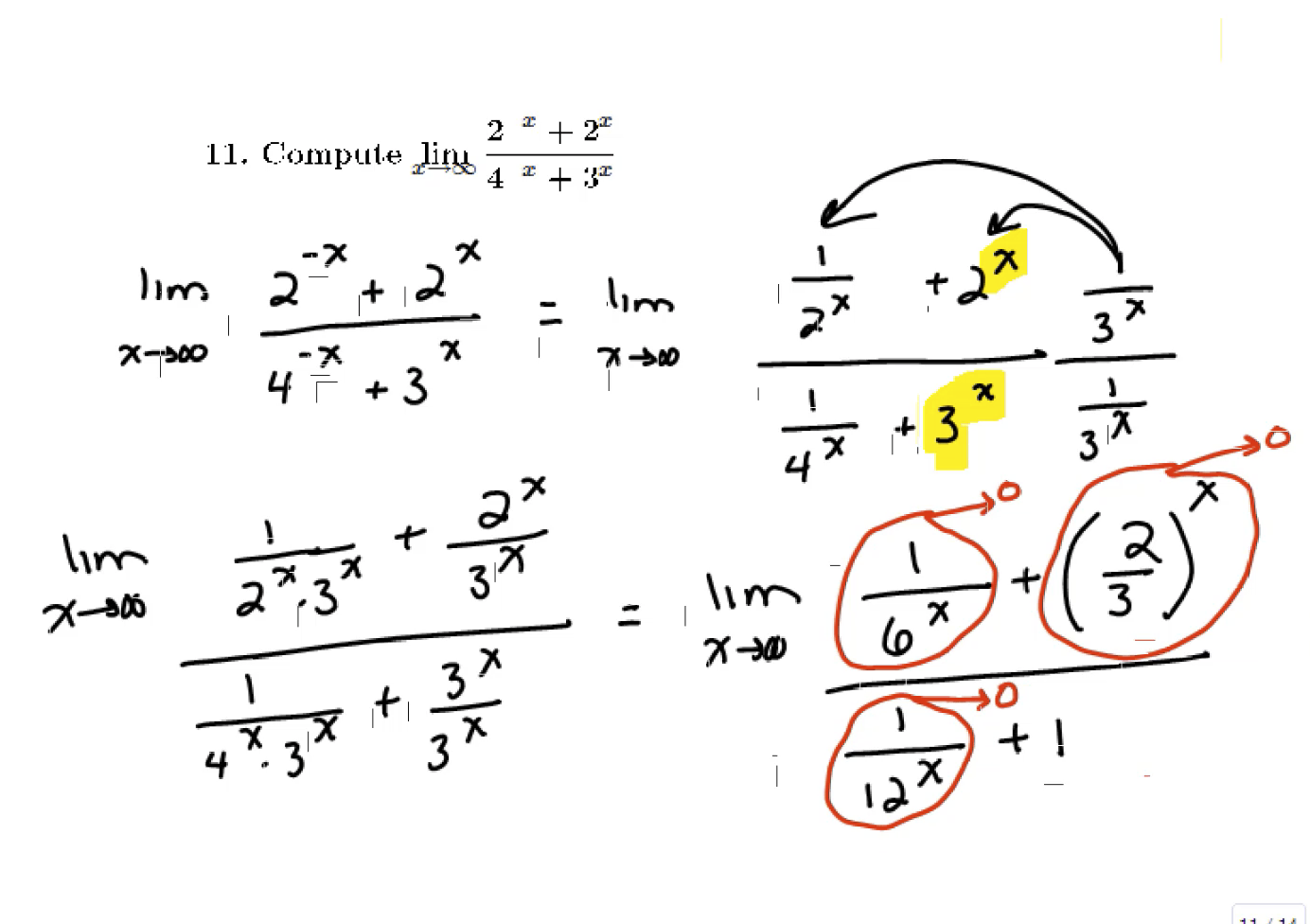
Approximation and Newton's Method, and limits and derivatives of exponential functions

Review of the limit definition of a derivative and calculating the derivative

Review of the limit definition of a derivative and calculating the derivative

Approximation and Newton's Method, and limits and derivatives of exponential functions

Derivatives of exponential and logarithmic functions and the exponential model

Derivatives of exponential and logarithmic functions and the exponential model

Using L'Hospital's Rule to solve limits

Using Reimann sums and the Fundamental Theorem of Calculus

Using Riemann sums and the Fundamental Theorem of Calculus

Examples of integration by substitution

Using the Product and Chain Rules to differentiate functions with logarithms

Differentiating functions with logarithmic and inverse trigonometric functions

Using logarithmic differentiation to find the derivative of a function

Using logarithmic differentiation to find the derivative of a function

Evaluating a limit using L'Hospital's Rule

Antidifferentiating twice to find a function from its second derivative

Antidifferentiating to find a function from its derivative

Antidifferentiating twice to find a function from its second derivative

Antidifferentiating twice to find a function from its second derivative

Using antidifferentiation to find the height of a cliff from the impact speed of a dropped stone

Evaluating a limit using logarithm properties

Evaluating a limit using L'Hospital's Rule

Evaluating a limit with an indeterminant power using L'Hospital's Rule

Evaluating a limit at infinity by combining logarithms

Finding a derivative using the Chain Rule and Product Rule

Evaluating a definite integral with an exponential and sine function

Using logarithmic differentiation to find the derivative of a function

Determining if a sequence is increasing, decreasing, or not monotonic and if it is bounded

Finding a power series representation for a function

Solving an improper integral where the upper limit of integration is infinity

Review of limits, continuity, and the Intermediate Value Theorem

Review of the limit definition of a derivative and calculating the derivative

Derivatives of exponential functions and the exponential model

Review of the limit definition of a derivative and calculating the derivative

Properties of inverse trig functions and the derivative of arctangent

Approximation and Newton's Method, and limits and derivatives of exponential functions

Review of the limit definition of a derivative and calculating the derivative

Review of the limit definition of a derivative and calculating the derivative

Approximation and Newton's Method, and limits and derivatives of exponential functions

Properties of inverse trig functions and the derivative of arctangent

Proving the derivative of ln(x) and the power and product rules using logarithmic differentiation

Derivatives of exponential and logarithmic functions and the exponential model

Proving L'Hospital's Rule and using it to evaluate limits

Using L'Hospital's Rule to solve limits

Using Reimann sums and the Fundamental Theorem of Calculus

Using Reimann sums and the Fundamental Theorem of Calculus

Examples of integration by substitution

Determining the domain of a three-dimensional vector function

Finding and sketching the domain of a function of two variables

Evaluating a double integral over a given region

Evaluating a double integral by reversing the order of integration

Performing basic numerical calculations in Python

Finding the domain of even and odd roots
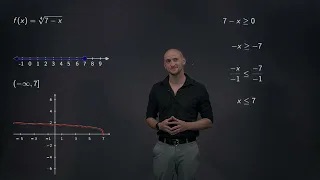
Finding the domain of functions with even and odd roots

Finding the domain of several rational functions

Finding the domain of a rational function

Explaining how to find any holes and vertical asymptotes of a rational function

Finding the domain of a rational function using factoring

Discussing how to write the equation of a line through two given points

Solving a linear equation algebraically and showing how this relates to the graph

Solving a linear equation algebraically

Solving a linear equation algebraically and showing how this relates to the graph

Explaining the format and possible solutions for a system of two linear equations

Solving a system of two linear equations using a TI-84 calculator

Solving a system of two linear equations using a TI-84 calculator

Explaining the standard form for a quadratic equation and the possible number of solutions

Solving quadratic equations with the difference of two squares formula
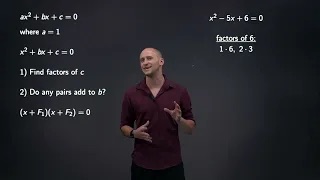
Solving quadratic equations by factoring

Solving a quadratic equation by factoring

Solving a quadratic equation by factoring

Solving quadratic equations with the quadratic formula and discussing the number of possible solutions

Explaining how to multiply and divide rational expressions

Performing algebraic operations with rational expressions and simplifying the answer

Finding the limit of a sequence using logarithm properties

Sketching the level curves for a function of two variables

Evaluating and then finding and sketching the domain of a function of two variables

Finding and sketching the domain of a function of two variables

Explaining the format and possible solutions for a system of two linear equations

Rewriting a function with a fractional exponent in radical form

Solving a rational equation and checking the solutions

Find the domain of a function in interval notation with a fraction and logarithm

Stating the domain in interval notation of a function with radicals, fractions, and exponentials

Finding the properties of a quadratic function such as the vertex, axis of symmetry, intercepts, etc.

Using properties of logarithms to write an expression as a single logarithm

Finding the composition of two functions with exponentials and logarithms

Expanding a logarithmic expression using logarithm properties

Condensing logarithmic expressions into a single logarithm

Finding the exact value of logarithms using logarithmic properties

Finding the vertical asymptote of a logarithmic function

Finding the vertical asymptote of a logarithmic function

Graphing a line without using technology

Graphing a line without using technology

Graphing a line without using technology

Writing a function for the value of an item depreciating linearly over time

Finding the solution to a system of linear equations by graphing

Graphing the solution set of an inequality with two variables

Graphing the solution set of an inequality with two variables

Graphing the solution set of system of linear inequalities

Explaining how to graph linear inequalities

Graphing two linear inequalities

Sketching the solution set and finding the corner points for a system of linear inequalities

Using a graph to find specific values of a function

Determining the end behavior, real zeros, domain, and y-intercept for a polynomial

Determining the end behavior, real zeros, domain, and y-intercept for a polynomial

Determining the end behavior, real zeros, domain, and y-intercept for a polynomial

Determining the end behavior, real zeros, domain, and y-intercept for a polynomial

Determining the end behavior, real zeros, domain, and y-intercept for a polynomial

Identifying quadratic functions and their properties

Finding the domain of a piecewise function and evaluating it

Calculating how much to invest with continuously compounded interest

Identifying the parent function and transformations for a given graph

Identifying the parent function and transformations for a given graph

Identifying the parent function and transformations for a given graph

Identifying the parent function and transformations in order for a given function

Drawing the graph of a transformed function given the original graph

Evaluating compositions of two given functions and the graph of a third function

Using the Horizontal Line Test to determine if graphs represent invertible functions

Finding the domain, intercepts, asymptotes, and holes of a rational function

Finding the domain, intercepts, asymptotes, and holes of a rational function

Finding the domain, intercepts, asymptotes, and holes of a rational function

Finding limits from the graph of a piecewise function

Solving the limits approaching infinity and negative infinity with exponential functions in the numerator and denominator

Finding the horizontal asymptotes of a function that is a fraction with exponentials in the numerator and denominator

Determining where a piecewise function is continuous from its graph

Determining where a function with a fraction, square root, and logarithm is continuous

Determining where the derivative of a function does not exist from a graph

Finding a derivative of a function with a logarithm using the Product Rule

Finding the derivative of a function with a square root and exponential using the Product Rule

Finding the derivative of a fraction with an exponential using the Quotient Rule

Finding a derivative using both the Product and Quotient Rule

Finding the derivative of a function using the Generalized Power Rule

Using the chain rule to find derivates with some values given in a table

Using implicit differentiation to find the derivative of a function

Finding the intervals where a function is increasing/decreasing and the local extrema

Finding intervals of increase/decrease and the local extema for revenue from a word problem

Finding the intervals of concavity and inflection points for a function with exponentials

Determining the intervals of concavity and inflection points from the graph of a function

Using the second derivative test to find local extrema for a function

Finding the absolute maximum and minimum of a rational function on two closed intervals

Finding the absolute maximum and absolute minimum of a rational function on two closed intervals

Finding the selling price of trucks to maximize profit given the cost and price-demand functions

Finding the dimensions of the box with the largest volume given the amount of material to make the box

Finding the minimum cost of a box given the volume and cost of materials

Finding the antiderivative of a function

Evaluating an indefinite integral with an exponential

Solving an indefinite integral with an exponential function suing u-substitution

Solving an indefinite integral with a natural logarithm using u-substitution

Solving an indefinite integral with exponentials in a quotient using u-substitution

Using u-substitution in an indefinite integral to find a function from its derivative and a given vaue

Explaining the Intermediate Value Theorem and the Bisection Method

Using the Intermediate Value Theorem and Bisection Method to approximate the solution of an equation

The definition of higher derivatives and solving an example

Using derivatives to find the velocity and acceleration functions from the position function

Calculating the derivative of a function with exponentials using the chain and product rule

Explaining exponential functions in discrete time

Solving a population example of exponential growth in discrete time

Solving a population grown example on recurrence equations

Explaining the Sandwich (or Squeeze) Theorem with a graphical example

Solving a limit at infinity using the Sandwich (or Squeeze) Theorem
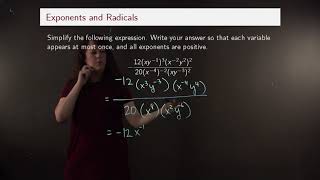
Simplifying a fraction using properties of exponents

Simplifying a fraction containing fractional exponents

Simplifying a fraction with negative exponents

Solving an equation using the quadratic formula

Solving a quadratic equation by completing the square

Solving a polynomial equation using factoring by grouping

Solving a quadratic equation using the quadratic formula

Determining if an equation represents a function

Finding the domains of functions

Finding the domains of expressions
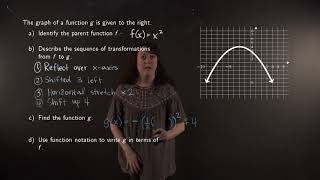
Identifying the parent function and transformations of a function

Identifying the parent function and transformations of a function

Graphically verifying if two functions are inverses

Determining the properties of a sine function and graphing it

Determining the properties of a cosine function and graphing it

Writing the equation for a sine function to match a given graph

Writing the equation for a cosine function to match a given graph

Solving a trigonometric equation

Solving a trigonometric equation

Solving a trigonometric equation by factoring

Solving a trigonometric equation

Solving a trigonometric equation

Solving a trigonometric equation

Solving a trigonometric equation

Using a double angle formula to solve a trigonometric equation

Using a double angle formula to solve a trigonometric equation

Using a double angle formula to solve a trigonometric equation

Using double angle formulas to evaluate trigonometric functions

Adding and subtracting vectors graphically

Finding the properties of a transformed tangent function and graphing it

Determining if a function is even or odd

Cartesian equations and parametric equations of curves

Derivatives and vectors with some physics applications

Review of derivatives and tangent lines to functions and vector equations

Antiderivatives and physics applications

Evaluating limits of functions

Evaluating Limits of Functions

Review of derivatives and tangent lines to functions and vector equations

Differentials, linear approximations and quadratic approximations

Derivatives and tangents to curves

Derivatives and vectors with some physics applications

Derivatives and vectors with some physics applications

Mean Value Theorem and properties of a graph

Mean Value Theorem and properties of a graph

Converting parametric equations into a Cartesian equation and graphing

Using the graph of a function to sketch a graph of its derivative

Finding a Cartesian equation for a parametric equation and graphing it

Find the Cartesian form and sketch the graph for the parametric equation of a line

Differentiating a function with an exponential function and using the Power Rule

Using the Product Rule to differentiate a function

Using the Quotient Rule to differentiate a function

Using the Product and Quotient Rules to differentiate a function

Using the Product Rule to find a first and second derivative

Using the Chain Rule to differentiate functions with exponential and trigonometric functions

Using the Chain Rule to find a first and second derivative

Using the Chain Rule to find the pattern for a higher order derivative

Finding the derivatives of compositions of functions from their graphs

Finding the derivative using implicit differentiation

Finding the derivative of a function containing a logarithmic function

Finding the derivatives of functions containing logarithms

Finding the derivative of a function containing a logarithms

Finding the equation of a tangent line to a function containing a logarithm

Using the Product and Chain Rule to find several derivatives

Using the Product, Quotient and Chain Rules to find several derivatives

Using the Quotient and Chain Rules to find several derivatives

Differentiating functions with inverse trigonometric functions

Finding the derivative of an implicit function

Finding the derivative of an implicit function

Using the chain rule to find a derivative

Finding a number that satisfies the conclusion of the Mean Value Theorem on an interval

Evaluating a limit using L'Hospital's Rule

Evaluating a limit with an indeterminate product using L'Hospital's Rule

Evaluating a limit with an indeterminant difference using L'Hospital's Rule

Antidifferentiating twice to find a function from its second derivative

Determining the properties of a function from the graph of its derivative

Evaluating a limit with an indeterminant product using L'Hospital's Rule

Finding the antiderivative of a function and using a function value to find the constant

Using L'Hospital's Rule to solve a limit with an indeterminant product

Using L'Hospital's Rule to solve a limit with an indeterminant difference

Using L'Hospital's Rule to solve a limit with an indeterminant power

Evaluating an indefinite integral by simplifying a fraction to powers of x

Evaluating a definite integral by first simplifying the integrand

Evaluating the limit at infinity of a fraction with exponential functions

Evaluating the limit at negative infinity of a fraction with exponential functions

Using u-substitution to evaluate an indefinite integral

Finding a derivative using the Quotient Rule

Review of estimating the sum of a series and the remainder

Review of using tests to determine if a series is absolutely convergent, convergent, and divergent

Review of improper integrals and the Comparison Theorem

Review of power series properties and writing functions as power series

Review of Taylor and Maclaurin Series and their properties

Review of Taylor Polynomials and Taylor's Inequality

Review of using tests to determine if a series is absolutely convergent, convergent, and divergent

Finding Taylor and Maclaurin Series for functions

Finding power series representations for functions and the radius and interval of convergence of the power series

Integrating an exponential function using u-substitution

Integrating a rational function using u-substitution

Integrating a rational function using u-substitution

Finding the area of a region bounded by curves

Finding the volume of a solid of revolution using the washer method

Finding the volume of a solid of revolution using cylindrical shells

Evaluating an integral using integration by parts

Evaluating an integral using integration by parts

Evaluating an integral using integration by parts

Evaluating an integral using integration by parts

Evaluating an integral using integration by parts

Evaluating an integral using integration by parts

Using the comparison test to determine if an improper integral converges or diverges

Determining if a sequence converges or diverges

Determining if a series converges or diverges and find the sum if it converges

Using the comparison test to determine if a series converges or diverges

Using the comparison test to determine if a series converges or diverges

Using the comparison test to determine if a series converges or diverges

Using the limit comparison test to determine if a series converges or diverges

Determining if a series is absolutely convergent, conditionally convergent, or divergent.

Determining if a series is absolutely convergent, conditionally convergent, or divergent.

Finding the interval and radius of convergence for a power series

Finding the Taylor polynomial of a function

Converting parametric equations into a Cartesian equation and graphing

Converting parametric equations into a Cartesian equation and graphing

Converting parametric equations into a Cartesian equation and graphing

Converting parametric equations into a Cartesian equation and graphing

Finding the length of a curve given by parametric equations

Finding the area of a region defined using polar coordinates

Finding the area of a region bounded by two curves

Solving an indefinite integral with an exponential function using integration by parts

Solving a definite integral with an exponential function using integration by parts

Solving an indefinite integral with a natural logarithm using integration by parts

Solving a definite integral with a natural logarithm using integration by parts

Solving an indefinite integral with an exponential function using integration by parts

Using integration by parts twice for an integral with sine and an exponential function

Using u-substitution to evaluate a definite integral with a natural logarithm

Using u-substitution on an indefinite integral with an exponential function, sine, and cosine

Using u-substitution to solve an indefinite integral with an exponential function

Solving an improper integral where the upper limit of integration is infinity

Solving an improper integral where the upper limit of integration is infinity

Proving associative and scalar multiplication properties for vectors

Cartesian equations and parametric equations of curves

Proving facts about the derivatives of vector functions including the product rule

Derivatives and vectors with some physics applications

Derivatives and vectors with some physics applications
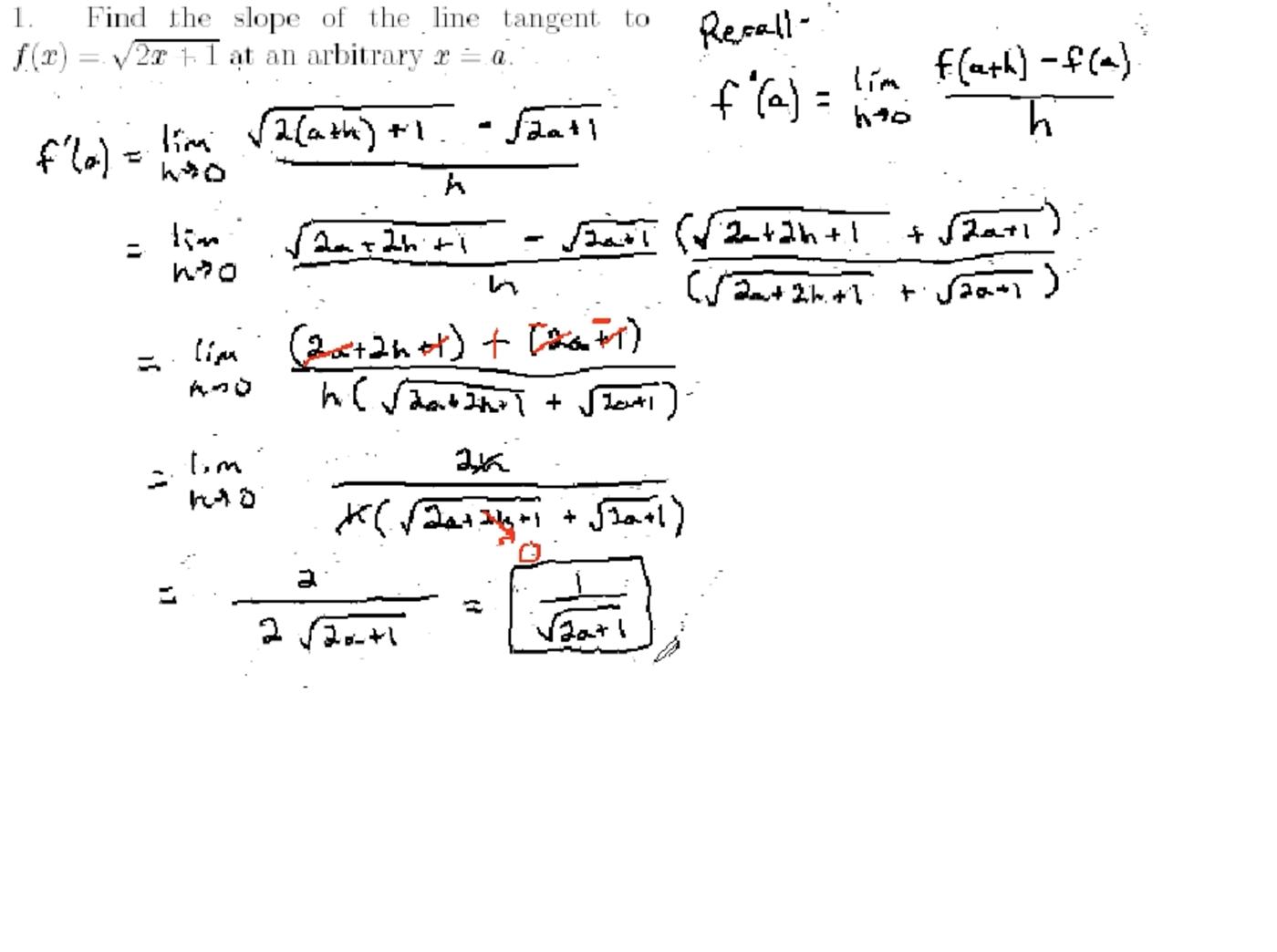
Using the limit definition to find derivatives of functions and vector functions

Review of derivatives and tangent lines to functions and vector equations

Antiderivatives and physics applications

Evaluating limits of functions

Evaluating limits of functions and using the Squeeze Theorem

Proving a piecewise function and a polynomial are continuous

Using the limit definition to find derivatives of functions and vector functions

Using the limit definition to find a derivative and proving the power rule

Using the limit definition to find derivatives of functions and vector functions

Review of derivatives and tangent lines to functions and vector equations

Using the limit definition to find a derivative and proving the power rule

Differentials, linear approximations, and quadratic approximations

Review of derivatives and tangent lines to functions and vector equations

Examples involving the tangent line to an exponential function and finding the derivative of hyperbolic cosine

Derivatives and vectors with some physics applications

Using implicit differentiation to solve a problem and to prove the power rule for rational exponents

Mean Value Theorem and properties of a graph

What the derivatives of a function tell us about the shape of its graph

Mean Value Theorem and properties of a graph

Optimizing values in word problems

Proving and then applying the Fundamental Theorem of Calculus

Using u substitution to evaluate integrals and prove facts about logarithms and integrals and

Review of estimating the sum of a series and the remainder

Review of using tests to determine if a series is absolutely convergent, convergent, and divergent

Review of improper integrals and the Comparison Theorem

Review of power series properties and writing functions as power series

Review of Taylor and Maclaurin Series and their properties

Review of Taylor Polynomials and Taylor's Inequality

Review of using tests to determine if a series is absolutely convergent, convergent, and divergent

Determining properties of sequences

Finding Taylor and Maclaurin Series for functions

Finding power series representations for functions and the radius and interval of convergence of the power series

Finding a partial fraction decomposition and integrating using partial fractions

Showing how an equation in three dimensional space represents a plane
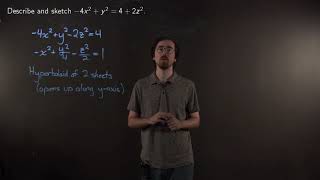
Identifying the equation of a hyperboloid and sketching its graph

Identifying the equation of a cone in three dimensions and sketching its graph

Finding the limit of a three-dimensional vector function

Finding the position vector function given the velocity and an initial position

Sketching the graph of a function of two variables

Sketching the graph of a function of two variables

Sketching the level curves of a function of two variables

Sketching the level curves of a function of two variables

Describing the level surfaces of a function of three variables

Finding the partial derivatives of a function of two variables

Finding the partial derivatives of a function of two variables

Finding all second-order partial derivatives of a function of two variables

Evaluating a double integral over a given region

Evaluating a double integral and sketching the region of integration

Changing the order of integration for a double integral

Setting up double integrals of Type I and II to give the volume of a solid under a surface

Evaluating a double integral over a circular region by changing to polar coordinates

Evaluating a double integral by changing to polar coordinates

Evaluating a double integral by changing to polar coordinates

Converting a double integral to a double integral in polar coordinates

Writing an iterated integral in polar coordinates that gives the volume of the solid that lies below a paraboloid

Writing an iterated integral in polar coordinates that gives the volume of the solid bounded by a cone

Writing an a triple integral over a given solid as an iterated integral

Evaluating a triple integral over a solid bounded by given surfaces

Writing an iterated integral that gives the volume of a solid

Evaluating a triple integral over a solid bounded by elliptic paraboloids

Writing a triple integral as an iterated integral in cylindrical coordinates

Converting an iterated triple integral into cylindrical and spherical coordinates

Using an iterated integral in spherical coordinates to find the volume of a solid

Evaluating a triple integral for a given solid by writing an iterated integral in spherical coordinates

Evaluating a line integral along a curve

Evaluating a line integral along a curve in space

Finding the curl and divergence of a three dimensional vector field

Evaluating a surface integral of a vector field

Using Python to find the tangent line to a parametric equation and plot the two graphs

Graphing a piecewise function using Python

Solving a multistep word problem in Python and graphing the resulting function

Using Python to approximate a definite integral using left endpoint Riemann sums

Using Python to find the equation of the tangent line to a curve and graphing the result

Using Python to plot an implicit curve and find a tangent line using implicit differentiation

Using Python to numerically estimate a limit, graphically estimate a limit, and find the exact limit

Showing how the exponential function is the solution to an initial value problem

Evaluating iterated integrals over the same region but with different orders of integration

Writing and then solving an iterated integral for a given region

Evaluating a double integral over a given region by splitting it into two double integrals

Using double integrals to calculate the weight of a plate given its density and size

Finding the domain of a function with a square root in the denominator

Explaining the main three forms for linear equations

Solving a system of linear equations with two variables

Solving a system of two linear equations with two variables using the elimination method

Solving a system of two linear equations using a TI-84 calculator

Writing a linear equation of profit from a business word problem

Finding horizontal asymptotes for rational functions
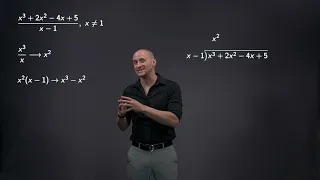
Explaining how to do polynomial long division

Finding horizontal asymptotes for rational functions

Determining the end behavior and horizontal asymptotes for rational functions

Explaining basic algebraic operations for fractions

How to simplify rational expressions

Adding and subtracting rational expressions by finding a common denominator

Finding the limit of a sequence

Sketching the level curves for a function of two variables

Introducing functions of several variables and level curves

Explaining that a graph is a collection of vertices and edges

Drawing a graph to depict a bus route

Counting the vertices and edges from a graph

Identifying the adjacent vertices in a graph

Finding two different paths between vertices in a graph

Determining if a list of vertices in a graph is a path, circuit, Euler path, Euler circuit, or none of the above

Determining if a list of vertices in a graph is a path, a circuits, an Euler path, an Euler circuit, or none of the above

Determining if a list of vertices in a graph is a path, a circuits, an Euler path, an Euler circuit, or none of the above

Determining if a list of vertices in a graph is a path, a circuits, an Euler path, an Euler circuit, or none of the above

Determining if a list of vertices in a graph is a path, a circuits, an Euler path, an Euler circuit, or none of the above

Determining if a list of vertices in a graph is a path, a circuits, an Euler path, an Euler circuit, or none of the above

Explaining Euler's Theorem on when a graph has an Euler path or Euler circuit

Finding the valence of each vertex in a graph

Explaining Hamiltonian Circuits and paths, the Method of Trees to find them, and the number of Hamiltonian circuits for complete graphs

Determining if a graph has a Hamiltonian path, Hamiltonian Circuit, or neither

Determining if a graph has a Hamiltonian path, Hamiltonian Circuit, or neither

Determining if a graph has a Hamiltonian path, Hamiltonian Circuit, or neither

Determining if a graph has a Hamiltonian path, Hamiltonian Circuit, or neither

Using the method of trees to find all Hamiltonian circuits of a graph starting at a given vertex

Determining if a graph is a complete graph

Determining if a graph is a complete graph

Determining if a graph is a complete graph

Determining if a graph is a complete graph

Finding two spanning trees for a graph

Finding the nth Taylor polynomial of the natural log function centered at 1

Introducing functions of several variables and level curves

Explanation of graphs for data and which are appropriate for categorical or numerical data

Finding the range, IQR, standard deviation, and variance for a given set of data

Solving a system of linear equations and giving a geometric interpretation of the solution

Solving a system of two linear equations in two unknowns by graphing

Simplifying an algebraic expression with exponents

Writing the domain of functions with radicals in interval notation

Calculating continuously compounded interest for money in an account

Finding the domain, intercepts, holes, and vertical asymptotes for a rational function

Finding the domain of a piecewise-defined function and evaluating it for given x-values

Finding properties of a polynomial function such as the degree, end behavior, y-intercept, etc.

Finding properties of a polynomial function such as the degree, end behavior, y-intercept, etc.

Finding the domain of a rational function

Finding the domain of a rational function

Finding the domain of a function with a fraction and radicals

Finding the domain of a function with a quadratic inside a square root

Finding the inverse of a linear function and its domain

Finding the inverse of a square root function and its domain

Finding the inverse of a rational function and its domain

Finding the inverse of a rational function and its domain

Finding the size of a population of rabbits with exponential growth

Finding the size of a population of rabbits with exponential decay

Finding the horizontal asymptote of an exponential function

Finding the horizontal asymptote of an exponential function

Finding the horizontal asymptote of an exponential function